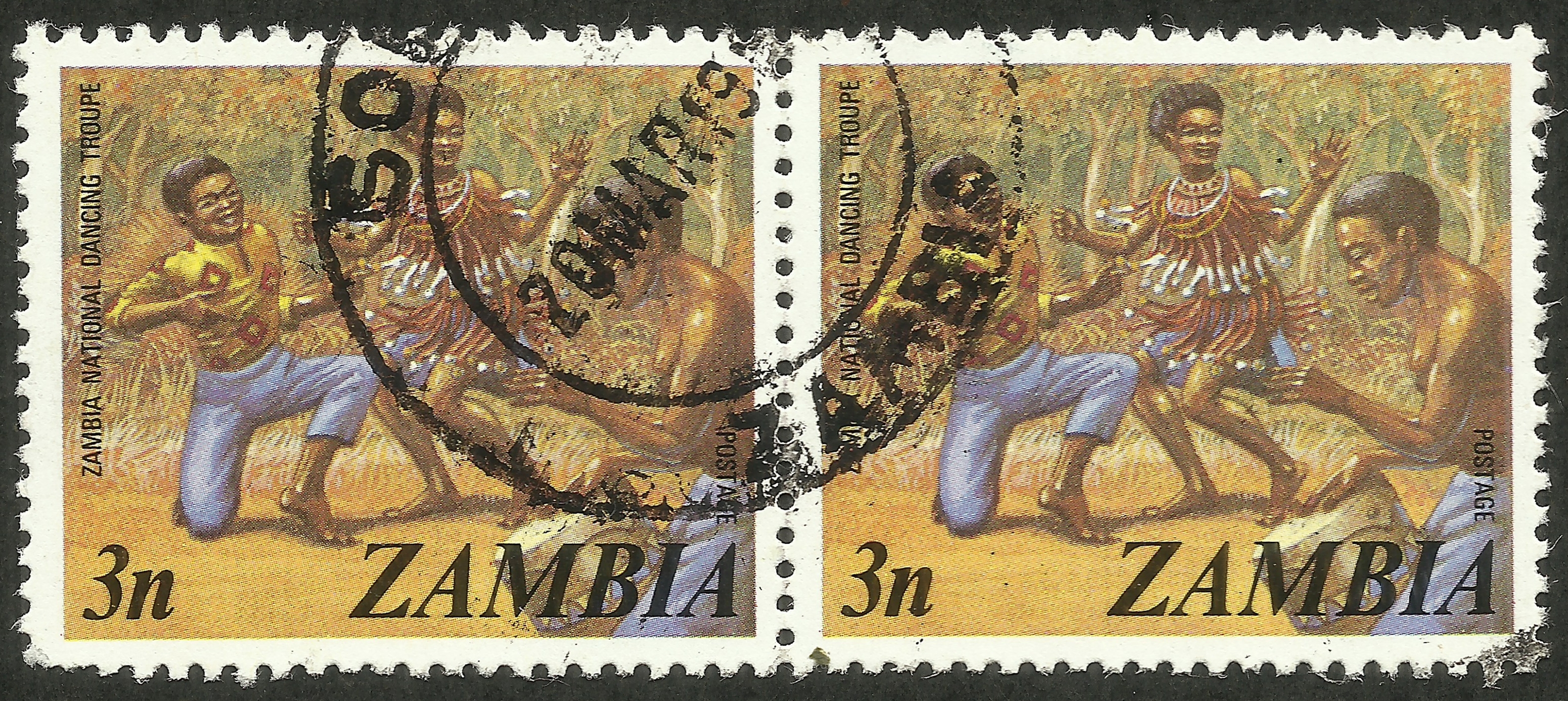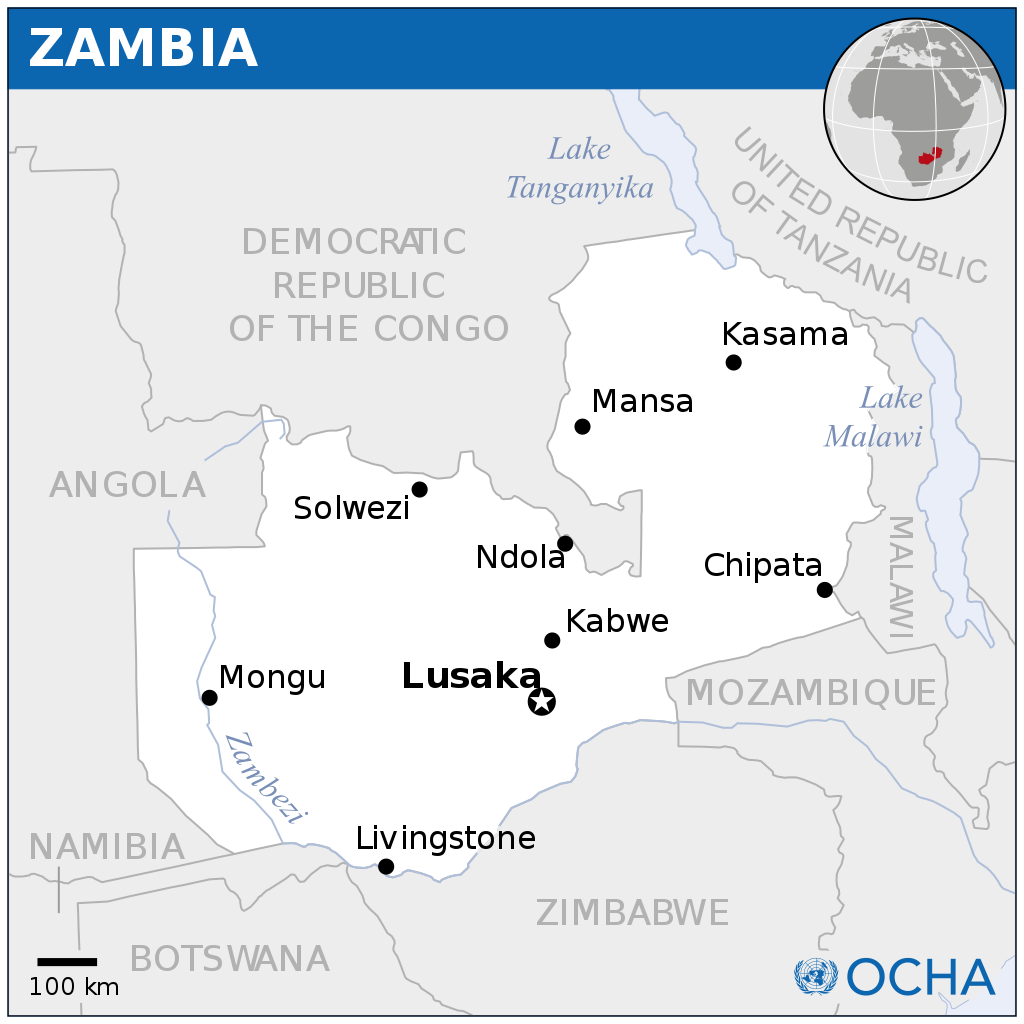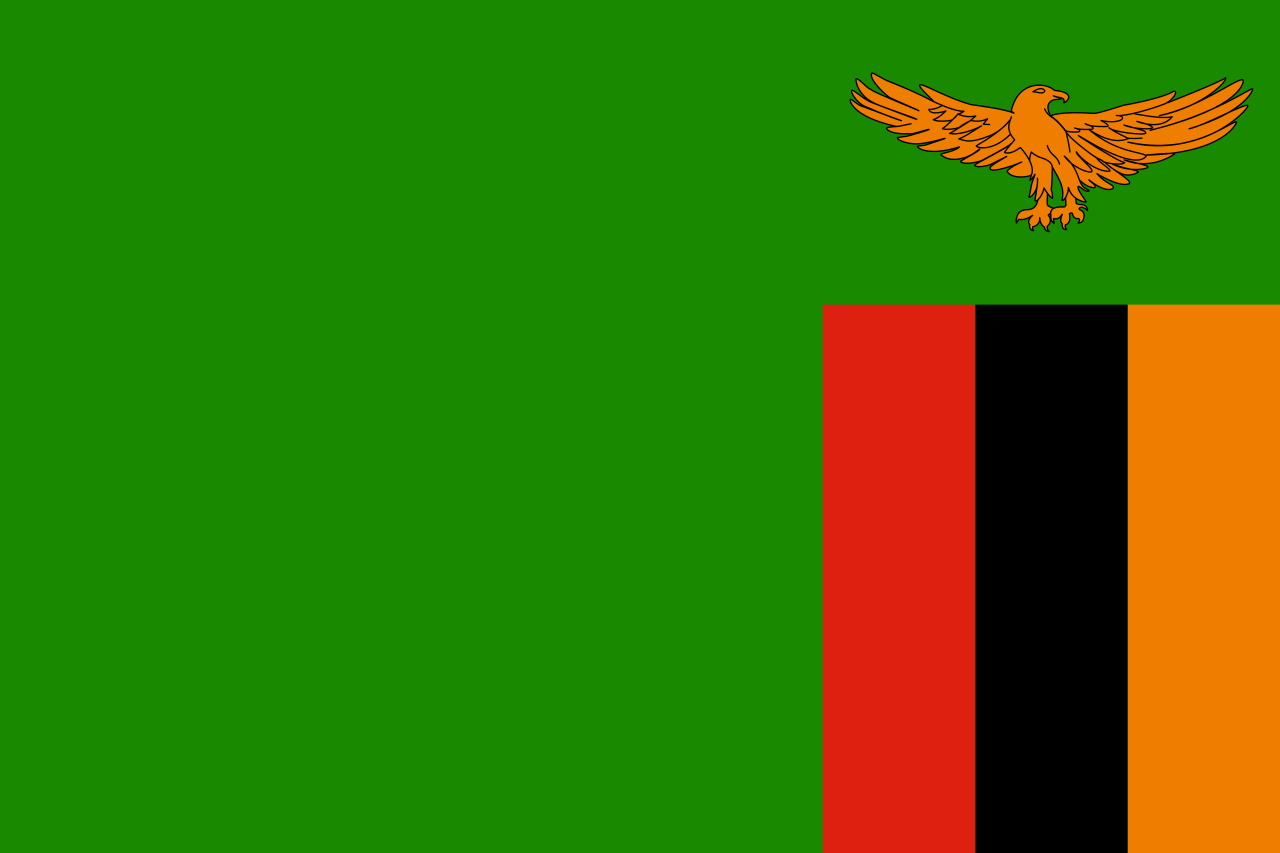
The Republic of Zambia, is a landlocked country in Southern Africa, neighbouring the Democratic Republic of the Congo to the north, Tanzaniato the north-east, Malawi to the east, Mozambique, Zimbabwe, Botswana, and Namibia to the south, and Angola to the west. The capital city is Lusaka, in the south-central part of Zambia. The population is concentrated mainly around Lusaka in the south and the Copperbelt Province to the northwest, the core economic hubs of the country.
Originally inhabited by Khoisan peoples, the region was affected by the Bantu expansionof the thirteenth century. After visits by European explorers in the eighteenth century, the region became the British protectorates of Barotziland-North-Western Rhodesia and North-Eastern Rhodesia towards the end of the nineteenth century. These were merged in 1911 to form Northern Rhodesia. For most of the colonial period, Zambia was governed by an administration appointed from London with the advice of the British South Africa Company.
On October 24, 1964, Zambia became independent of the United Kingdom and prime minister Kenneth Kaunda became the inaugural president. Kaunda’s socialist United National Independence Party (UNIP) maintained power from 1964 until 1991. Kaunda played a key role in regional diplomacy, cooperating closely with the United States in search of solutions to conflicts in Rhodesia (Zimbabwe), Angola, and Namibia. From 1972 to 1991 Zambia was a one-party state with the UNIP as the sole legal political party under the motto “One Zambia, One Nation”. Kaunda was succeeded by Frederick Chiluba of the social-democratic Movement for Multi-Party Democracy in 1991, beginning a period of social-economic growth and government decentralisation. Levy Mwanawasa, Chiluba’s chosen successor, presided over Zambia from January 2002 until his death in August 2008, and is credited with campaigns to reduce corruption and increase the standard of living. After Mwanawasa’s death, Rupiah Banda presided as Acting President before being elected President in 2008. Holding office for only three years, Banda stepped down after his defeat in the 2011 elections by Patriotic Front party leader Michael Sata. Sata died on October 28, 2014, the second Zambian president to die in office. Guy Scott served briefly as interim president until new elections were held on January 20, 2015, in which Edgar Lungu was elected as the sixth President.
In 2010, the World Bank named Zambia one of the world’s fastest economically reformed countries. The Common Market for Eastern and Southern Africa (COMESA) is headquartered in Lusaka.
The territory of what is now Zambia was known as Northern Rhodesia from 1911. It was renamed Zambia at independence in 1964. The new name of Zambia was derived from the Zambezi river (Zambezi may mean “River of God”).
The area of modern Zambia is known to have been inhabited by the Khoisan until around AD 300, when migrating Bantu began to settle around these areas. These early hunter-gatherer groups were later either annihilated or absorbed by subsequent more organized Bantu groups.
Archaeological excavation work on the Zambezi Valley and Kalambo Falls show a succession of human cultures. In particular, ancient camping site tools near the Kalambo Falls have been radiocarbon dated to more than 36,000 year ago.
The fossil skull remains of Broken Hill Man, dated between 300,000 and 125,000 years BC, further shows that the area was inhabited by pre-historic man.
The early history of the peoples of modern Zambia can only be gleaned from knowledge passed down by generations through word of mouth.
In the 12th century, waves of Bantu-speaking immigrants arrived during the Bantu expansion. Among them, the Tonga people (also called Ba-Tonga, “Ba-” meaning “men”) were the first to settle in Zambia and are believed to have come from the east near the “big sea”. The Nkoya people also arrived early in the expansion, coming from the Luba–Lunda kingdoms in the southern parts of the modern Democratic Republic of the Congo and northern Angola, followed by a much larger influx, especially between the late 12th and early 13th centuries.
By the late 12th century, more advanced kingdoms and empires had been established in most regions of modern Zambia.
To the east, the Maravi Empire, also spanning the vast areas of Malawi and parts of modern northern Mozambique began to flourish under Kalonga.
At the end of the 18th century, some of the Mbunda migrated to Barotseland, Monguupon the migration of among others, the Ciyengele. The Aluyi and their leader, the Litunga Mulambwa, especially valued the Mbunda for their fighting ability.
In the early 19th century, the Nsokolo people settled in the Mbala district of Northern Province. During the 19th century, the Ngoniand Sotho peoples arrived from the south. By the late 19th century, most of the various peoples of Zambia were established in their current areas.
The earliest European to visit the area was the Portuguese explorer Francisco de Lacerda in the late 18th century. Lacerda led an expedition from Mozambique to the Kazembe region in Zambia (with the goal of exploring and to crossing Southern Africa from coast to coast for the first time), and died during the expedition in 1798. The expedition was from then on led by his friend Francisco Pinto. This territory, located between Portuguese Mozambique and Portuguese Angola, was claimed and explored by Portugal in that period.
Other European visitors followed in the 19th century. The most prominent of these was David Livingstone, who had a vision of ending the slave trade through the “3 Cs”: Christianity, Commerce and Civilization. He was the first European to see the magnificent waterfalls on the Zambezi River in 1855, naming them the Victoria Falls after Queen Victoria. He described them thus: “Scenes so lovely must have been gazed upon by angels in their flight”.
Locally the falls are known as “Mosi-o-Tunya” or “thundering smoke” in the Lozi or Kololo dialect. The town of Livingstone, near the Falls, is named after him. Highly publicized accounts of his journeys motivated a wave of European visitors, missionaries and traders after his death in 1873.
In 1888, the British South Africa Company (BSA Company), led by Cecil Rhodes, obtained mineral rights from the Litunga of the Lozi people, the Paramount Chief of the Lozi (Ba-rotse) for the area which later became Barotziland-North-Western Rhodesia. To the east, in December 1897 a group of the Angoni or Ngoni (originally from Zululand) rebelled under Tsinco, son of King Mpezeni, but the rebellion was put down, and Mpezeni accepted the Pax Britannica. That part of the country then came to be known as North-Eastern Rhodesia. In 1895, Rhodes asked his American scout Frederick Russell Burnham to look for minerals and ways to improve river navigation in the region, and it was during this trek that Burnham discovered major copper deposits along the Kafue River.
North-Eastern Rhodesia and Barotziland-North-Western Rhodesia were administered as separate units until 1911 when they were merged to form Northern Rhodesia, a British protectorate. In 1923, the BSA Company ceded control of Northern Rhodesia to the British Government after the government decided not to renew the Company’s charter.
In 1923, Southern Rhodesia (now Zimbabwe), a conquered territory which was also administered by the BSA Company, became a self-governing British colony. In 1924, after negotiations, administration of Northern Rhodesia transferred to the British Colonial Office.
In 1953, the creation of the Federation of Rhodesia and Nyasaland grouped together Northern Rhodesia, Southern Rhodesia and Nyasaland (now Malawi) as a single semi-autonomous region. This was undertaken despite opposition from a sizeable minority of the population, who demonstrated against it in 1960–61. Northern Rhodesia was the centre of much of the turmoil and crisis characterising the federation in its last years. Initially, Harry Nkumbula’s African National Congress (ANC) led the campaign, which Kenneth Kaunda’s United National Independence Party (UNIP) subsequently took up.
A two-stage election held in October and December 1962 resulted in an African majority in the legislative council and an uneasy coalition between the two African nationalist parties. The council passed resolutions calling for Northern Rhodesia’s secession from the federation and demanding full internal self-government under a new constitution and a new National Assembly based on a broader, more democratic franchise.
The federation was dissolved December 31, 1963, and in January 1964, Kaunda won the only election for Prime Minister of Northern Rhodesia. The Colonial Governor, Sir Evelyn Hone, was very close to Kaunda and urged him to stand for the post. Soon after, there was an uprising in the north of the country known as the Lumpa Uprising led by Alice Lenshina – Kaunda’s first internal conflict as leader of the nation.
Northern Rhodesia became the Republic of Zambia on October 24, 1964, with Kenneth Kaunda as the first president. At independence, despite its considerable mineral wealth, Zambia faced major challenges. Domestically, there were few trained and educated Zambians capable of running the government, and the economy was largely dependent on foreign expertise. This expertise was provided in part by John Willson CMG. There were over 70,000 Europeans resident in Zambia in 1964, and they remained of disproportionate economic significance.
Kaunda’s endorsement of Patriotic Front guerrillas conducting raids into neighboring (Southern) Rhodesia resulted in political tension and a militarisation of the border, leading to its closure in 1973. The Kariba hydroelectric station on the Zambezi River provided sufficient capacity to satisfy the country’s requirements for electricity, despite Rhodesian management.
On September 3, 1978, a Russian-supplied heat-seeking missile was used to shoot down a civilian airliner, Air Rhodesia Flight 825, near Kariba. Miraculously, 18 people, including children, survived the crash only for most of them to be shot in cold blood by militants of the Zimbabwe African People’s Union (ZAPU) led by Joshua Nkomo. Rhodesia responded with Operation Gatling, an attack on Nkomo’s guerilla bases in Zambia, in particular his military headquarters just outside Lusaka; this raid became known as the Green Leader Raid. On the same day, two more bases in Zambia were attacked using air power and elite paratroops and helicopter-borne troops.
A railway (TAZARA – Tanzania Zambia Railways) to the Tanzanian port of Dar es Salaam, completed in 1975 with Chinese assistance, reduced Zambian dependence on railway lines south to South Africa and west through an increasingly troubled Portuguese Angola. Until the completion of the railway, Zambia’s major artery for imports and the critical export of copper was along the TanZam Road, running from Zambia to the port cities in Tanzania. The Tazama oil pipeline was also built from Dar es Salaam to Ndola in Zambia.
By the late 1970s, Mozambique and Angola had attained independence from Portugal. Rhodesia’s predominantly white government, which issued a Unilateral Declaration of Independence in 1965, accepted majority rule under the Lancaster House Agreement in 1979.
Civil strife in both Portuguese colonies and a mounting Namibian War of Independence resulted in an influx of refugees and compounded transportation issues. The Benguela railway, which extended west through Angola, was essentially closed to Zambian traffic by the late 1970s. Zambia’s support for anti-apartheid movements such as the African National Congress (ANC) also created security problems as the South African Defence Force struck at dissident targets during external raids.
In the mid-1970s, the price of copper, Zambia’s principal export, suffered a severe decline worldwide. In Zambia’s situation, the cost of transporting the copper great distances to market was an additional strain. Zambia turned to foreign and international lenders for relief, but, as copper prices remained depressed, it became increasingly difficult to service its growing debt. By the mid-1990s, despite limited debt relief, Zambia’s per capita foreign debt remained among the highest in the world.
In June 1990, riots against Kaunda accelerated. Many protesters were killed by the regime in breakthrough June 1990 protests. In 1990 Kaunda survived an attempted coup, and in 1991 he agreed to reinstate multiparty democracy, having instituted one party rule under the Choma Commission of 1972. Following multiparty elections, Kaunda was removed from office.
In the 2000s, the economy stabilized, attaining single-digit inflation in 2006–2007, real GDP growth, decreasing interest rates, and increasing levels of trade. Much of its growth is due to foreign investment in mining and to higher world copper prices. All this led to Zambia being courted enthusiastically by aid donors, and saw a surge in investor confidence in the country.
In the 1890s, mail from North-Western Rhodesia was carried by runner to Bulawayo, while North-Eastern Rhodesia mail went via British Central Africa until 1895.
Before and after its creation, Northern Rhodesia used the stamps of Rhodesia. The change to protectorate included a change of stamps, and on April 1, 1925, Northern Rhodesia issued its first stamps. Inscribed NORTHERN RHODESIA, the seventeen values all depicted a wilderness scene with elephants and a giraffe, surmounted by a profile of King George V. The same design was adapted for King George VI in 1938.
Upon the death of King George VI in February, 1952, Elizabeth II came to the throne, and a new set of Northern Rhodesia stamps was issued with her portrait. Only a few months later, these Northern Rhodesian stamps were withdrawn, and Federation stamps were issued in their place.
Northern Rhodesia’s first commemorative stamps were a set of five on May 30, 1953, marking the birth centennial of Cecil Rhodes, along with another stamp issued on the same day for the Rhodes Centenary Exhibition. As Elizabeth II of the United Kingdom was already on the throne, the stamps included her profile, even though the official coronation stamp did not come out until June 2. This was followed in September by a definitive series using the same design as before, with the monarch’s profile updated once again.
Northern Rhodesia joined the Federation of Rhodesia and Nyasaland in 1953, and used the Federation’s stamps until it was dissolved in 1963. On December 10, 1963, a new definitive series depicted the Queen and the territory’s arms, but these were withdrawn on October 23, 1964, when Zambia became independent.
The first stamps of independent Zambia were issued on October 24, 1964. They consisted of a set of three commemoratives. On the same day, a set of 14 definitives was issued, with depictions of various professions and scenes.
Scott #137 was part of a set of 14 definirtives released on January 3, 1975. The stamps portray animals, birds, scenery and people. They were lithographed with the eight lowest values perforated 13½x14 and the remainder perforated 13. The 3-n denomiation pictures Zambian dancers.




